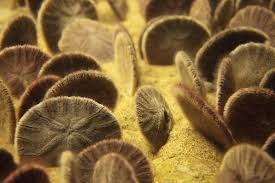What is a sand dollar? What are its features?« Back to Questions List
|
Sand dollar is a species of flattened, burrowing sea urchins. Small, spiny, globular animals in the sea are known as sea urchins or urchins. The speciality of sand dollar is that they are extremely flattened. It is also known as sea cookie or snapper biscuit because of the special shape. Another thick variety is known as sea biscuits. Most shells found at beaches were once part of a clam, snail or other mollusk. Flat ones with a pattern of holes resembling a five-petaled flower are however from the sand dollar. Sand dollars live around the globe in northern seas, on sand flats and deeper water. Like other sea urchins, a sand dollar is covered with spines – in case a velvety coat of short, purplish spikes. The velvety spikes of live sand dollars have different colours depending on the species. There are many species. Common colours are blue, green, violet, or purple. The mouth, on the underside is equipped with chewing jaws. Tube feet, arranged in the shape of a flower, protrude through holes in the shell, which is known as test. It consists of calcium carbonate plates arranged in a radial pattern. They are used in breathing, feeding and moving about. A sand dollar travels with a wavelike motion of its feet and spines. Travel occurs with coordinated movements of the spines. It can be found in temperate and tropical zones. Rough water washes them away as they are not strong enough to withstand such conditions. They cannot survive out of water. Sand dollars often live in crowds. They have a life span of six to ten years. The age of a sand dollar can be decided by counting the number of rings in the skelton. They play an important role in our local ecosystem. Live sand dollars regulate populations of smaller invertebrates. At the same time sand dollars are food for some larger organisms, including nine-armed sea stars. They often burrow to hide or eat. The food particles that land on the spikes are moved to mouth using tube feet. For reproduction, they spray egg and sperm to open water and larvae come together on their own. Sand dollars are affected by fishing, climate change and acidification of ocean. What is unusual about reproduction of seahorse? What is an Automatic Braking System?What is the Great Barrier Reef? |

